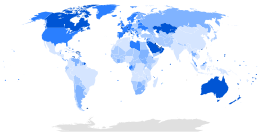Immigration
![]()
This article deals with migration from the perspective of the country receiving migrants. The article Sociology of Migration deals with this topic in greater generality and refers to other articles in this subject area, such as Asylum or Labour Migration. For the films, see the clarification The Immigrant.
People who, individually or in groups, leave their previous places of residence to settle in other places permanently or at least for a longer period of time are referred to as migrants. Commuters, tourists and other short-term stays are not included in the definition of migration; seasonal labour migration is sometimes included.
When people cross national borders in the course of their migration, they are called immigrants (from the Latin migrare, to migrate) from the perspective of the country they are entering. (From the perspective of the country they are leaving, they are called emigrants). Sociology usually refers to immigration as in-migration (as well as emigration corresponding to out-migration).
Although the Latin word "migrant" literally means "migrant", immigrants whose migration process has been completed are also referred to as "migrants" until they become linguistically "people with a migration background". Their descendants born in the country of immigration are also referred to as "people with a migration background", especially in the context of population statistics, even if they themselves did not participate in any migration process.
Globally, the number of immigrants (i.e. those who have moved their permanent residence from abroad to the country of reference during their lifetime) is estimated at 231.5 million, or 3.25% of the world's population. Migration is a significant change in a person's life and is associated with major, sometimes life-threatening risks (see unauthorised migration), and often tears apart family ties and social structures.
The modern image of immigration is to be seen in the context of the concepts of nation states and nationalities as well as passports, borders with border controls and citizenship law. In many states, immigrants as non-citizens have limited rights in relation to citizens, especially the right to settle is sometimes strictly limited by immigration laws (see also Aliens Law). Immigration without legal permission or violation of the limits set by the form of residence permit - so-called illegal immigration - can be punishable and usually leads to arrest and conviction and/or deportation by state authorities.
Immigrants, unless they are return migrants, are sometimes different from the inhabitants of a state. This can lead to problems and tensions between immigrants and the long-established inhabitants of the country. This also depends on culture, mentality and traditions (e.g. hospitality, xenophobia), economic situation or prospects and many other factors. Sometimes immigrants and locals perceive the same tension or problem very differently. In many countries, there have been debates about integration or assimilation and the effects of multiculturalism for decades.

European immigrants arrive in Argentina

World map with coloured percentage of immigrants per country in 2005
Stats
See also: List of countries by net migration rate and immigrant shares by country
According to a 2006 report by the United Nations (UN) General Secretariat on Global Immigration and Development, there are approximately 200 million immigrants worldwide. The UN defines an international migrant as a person who leaves his or her place of habitual residence - understood as the place where he or she spends daily or weekly rest and leisure time - and settles in another place in another state, making it the new place of habitual residence.
According to this UN definition, the percentage of immigrants in selected member states in Europe in 2014 was as follows:
| Country | Share | Most represented countries of origin |
| Luxembourg | 45,28 % | Portugal, France, Italy |
| Spain | 10,06 % | Romania, Morocco, Ecuador |
| Austria | 12,42 % | Germany, Serbia, Turkey |
| Belgium | 11,29 % | Italy, France, Netherlands |
| Germany | 8,68 % | Turkey, Russia, Poland |
| United Kingdom | 7,77 % | Ireland, India, Pakistan |
| Italy | 8,1 % | Romania, Albania, Morocco |
| Sweden | 7,12 % | Finland, Iraq, Poland |
| France | 6,31 % | Algeria, Morocco, Portugal |
| Netherlands | 4,37 % | Turkey, Morocco, Indonesia |
Migration movements in the 20th century
- Religious, cultural and political persecution in many countries, especially in Europe and the Middle East, led in the 20th century, especially in the 1930s, to liberals and Jews, for example, emigrating to more open societies, such as the United States of America, Canada or Australia.
- Some 12 to 14 million Germans and ethnic Germans from various states were affected by flight and expulsion between 1944/45 and 1950.
- The end of the colonial era led to many people coming to the (still or no longer) colonial countries from overseas colonies, especially in metropolises such as London, Paris and Brussels.
- The decades-long German economic upswing after the war led to the recruitment of so-called guest workers from countries such as Turkey, Italy, Spain, Greece, Morocco or Yugoslavia (labour migration). The number of immigrants continued to increase due to family reunification. Guest workers usually had temporary contracts and were only supposed to stay in Germany for a while. The majority therefore eventually returned to their countries of origin, but a small proportion remained in Germany. As a result, even after the recruitment stop in 1973, millions of people from the former guest worker countries followed the guest workers. They sought work in Germany or migrated for other reasons and generally remained in the country. Other Western European countries concluded similar agreements.
- After the end of the Second World War and until the fall of the Iron Curtain in 1989, many people fled political persecution from the countries of the former Eastern Bloc to the West.
- After the fall of the Iron Curtain, many Eastern European migrants came to Western Europe.
- After the surrender of South Vietnam in 1975, over 1.6 million South Vietnamese fled the country on boats (so-called boat people) in the following 20 years. Many of them managed to immigrate to a Western country, either directly or via intermediate stops.
- As a result of the collapse of the Soviet Union, ethnic German immigrants came to Germany in the early 1990s.
- Due to political causes such as war, upheaval or political persecution, numerous people from the Near and Middle East and Africa applied for asylum in Germany and elsewhere, especially in the 1980s and 1990s.
- From war zones such as the disintegrating Yugoslavia, hundreds of thousands of people from the Balkan countries came to Western Europe in the 1990s, mostly to German-speaking countries.
- Up to the present, refugee movements from dysfunctional or war- and civil war-affected countries in Africa and the Middle East (incl. Afghanistan) to the global North have increased sharply, culminating in the refugee crisis in Europe from 2015.

Information board on immigration in the border area between Mali and Mauritania; financed by the EU
Questions and Answers
Q: What is immigration?
A: Immigration is when people move from their native regions to live in another country.
Q: What are people called who immigrate to another country?
A: People who immigrate to another country are called immigrants.
Q: Are all immigrants legal?
A: No, not all immigrants are legal. Some are illegal immigrants.
Q: What are some types of immigrants?
A: Some types of immigrants include refugees and those who ask for political asylum.
Q: What does someone need to do to become a legal citizen of the United States?
A: To become a legal citizen of the United States, someone needs to apply and be accepted. Once accepted, they will receive a green card which they must keep for at least five years.
Q: What is a green card?
A: A green card is a piece of evidence stating that someone is trying to legally stay within a country's borders.
Q: What is the difference between an immigrant and an emigrant?
A: An immigrant is someone who arrives in a new country to live, while an emigrant is someone who leaves their own country or region. The same person can be referred to as an emigrant when leaving their home country and an immigrant when arriving somewhere else.
Search within the encyclopedia